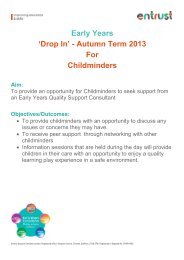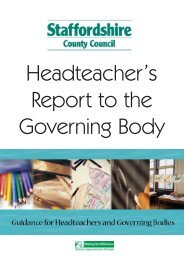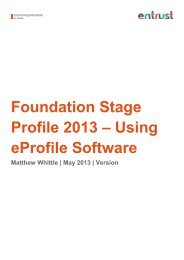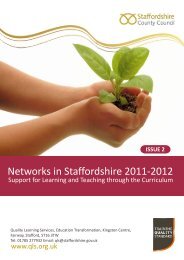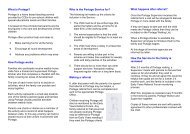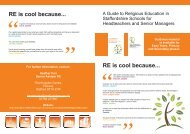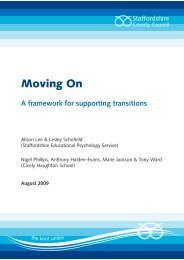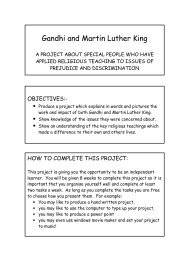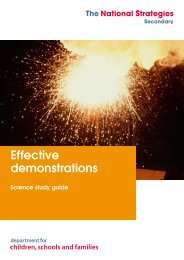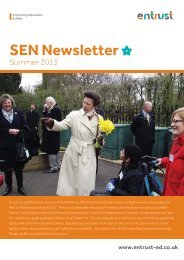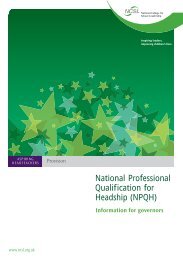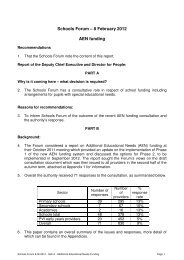Reading skills_save for pdf - Staffordshire Learning Net ...
Reading skills_save for pdf - Staffordshire Learning Net ...
Reading skills_save for pdf - Staffordshire Learning Net ...
You also want an ePaper? Increase the reach of your titles
YUMPU automatically turns print PDFs into web optimized ePapers that Google loves.
REVISED - STAFFORDSHIRE GUIDED READING RECORDS<br />
Y3 GUIDED READING RECORD Year Term<br />
Group: <strong>Reading</strong> Target:<br />
AF1 AF2 AF3 AF4 AF5 AF6 AF7<br />
Use a range of strategies,<br />
including accurate decoding of<br />
text, to read <strong>for</strong> meaning<br />
Year 3 Objectives<br />
5. Word recognition: decoding (reading)<br />
Note: Y3 is a significant year <strong>for</strong> moving<br />
the emphasis on teaching from word<br />
recognition to language comprehension.<br />
For this reason, there is no content <strong>for</strong><br />
strand 5 after Year 2. Children working<br />
significantly above or beow age-related<br />
expectaions will need differentiated<br />
support, which may include tracking<br />
<strong>for</strong>ward or back in terms of learning<br />
objectives.<br />
7. Understanding and interpreting texts<br />
1. Identify and make notes of the main<br />
points of section(s) of text<br />
2. Infer charcters’ feelings in fiction and<br />
consequences in logical explanations<br />
3. Identify how different texts are<br />
organised, including reference texts,<br />
magazines and leaflets, on paper and<br />
on screen<br />
4. Use syntax, content and word structure<br />
to build their store of vocabulary as they<br />
read <strong>for</strong> meaning<br />
5. Explore how different texts appeal to<br />
readers using varied sentence<br />
structures and descriptive language<br />
8. Engaging with & responding to texts<br />
1. Share and compare reasons <strong>for</strong> reading<br />
preferences, extending the range of<br />
books read<br />
2. Empathise with characters and debate<br />
moral dilemmas portrayed in texts<br />
3. Identify features that writers use to<br />
provoke readers’ reactions<br />
Understand, describe, select or<br />
retrieve in<strong>for</strong>mation, events or<br />
ideas from texts and use<br />
quotation and reference to text<br />
Deduce, infer or interpret<br />
in<strong>for</strong>mation, events or ideas from<br />
texts<br />
Identify and comment on the<br />
structure and organisation of<br />
texts, including grammatical and<br />
literary features at text level<br />
Explain and comment on the<br />
writers’ use of language,<br />
including grammatical and<br />
literary features at word and<br />
sentence level<br />
Date Text Obj AFs Names Comments<br />
Identify and comment on writer’s<br />
purposes and viewpoints and the<br />
overall effect of the text on the<br />
reader<br />
Relate texts to their social,<br />
cultural and historical contexts<br />
and literary traditions<br />
Our popular Guided <strong>Reading</strong> Records<br />
have been revised to bring them fully into<br />
line with both ‘The Staf<strong>for</strong>dshire <strong>Reading</strong><br />
Skills Grids’ and Assessing Pupils’ Progress<br />
materials. They are available on the<br />
English and Literacy area of the Staf<strong>for</strong>dshire website:<br />
www.education.staf<strong>for</strong>dshire.gov.uk/curriculum/subjectareas<br />
New!



